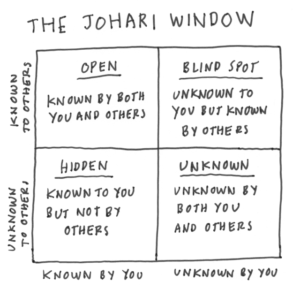The Johari Window – A Cool Tool
The spirit of recent posts has been to describe practical tools to help leaders avoid killing off their teams with aimless and unproductive meetings.
The first, Death by Meetings, obviously hit a nerve as it was opened by more than 17,000 readers. It featured off-beat ideas like employing rubber chickens or poker chips (https://www.tildensst.com/2018/02/06/death-by-meetings-try-this/) to remedy dysfunctional meetings.
Death by Meetings 2.0 (https://www.tildensst.com/2018/03/02/death-by-meetings-2-0/) followed up with six practical solutions for making meetings useful starting by cancelling them if there is not enough meaningful content for an agenda.
The Premortem a Remedy for Groupthink (https://www.tildensst.com/2018/04/23/the-premortem-a-remedy-to-groupthink/), is a technique that both engages Introverts and encourages dissent. The leader invokes a premortem when she asks team members to project into the future and write short stories on why the decision they are about to implement failed miserably.
In keeping with the spirit of practical tools, this post is on the Johari Window. While originally intended as a therapeutic and group development tool, I have found many practical business applications of this simple 2X2 matrix introduced in 1955 by two psychologists named Joseph Luft and Hattington Ingam. To have some fun and to lend a mystical quality to it, they employed their given names and titled it the Johari Window. It is illustrated above.
One application I have found helpful has been in coaching salespeople when analyzing competitive position. Naive salespeople believe the prospect is only considering the proposal he is pitching. In fact, the people on the other side of the table are typically considering multiple proposals simultaneously. The Johari window is a cool tool for moving the analysis from just the “Open” quadrant where both the prospect and the salesperson know what is being proposed.
Looking at the “Blind Spot”, or what the prospect knows and the salesperson doesn’t, can be, pardon the pun, unveiling. If nothing else it can lead to a good line of questions like learning criteria for the prospect’s decision making. Too often, salespeople believe decisions revolve on price exclusively when other criteria like service, reliability, implementation time, shared values and trustworthiness are more important. A good straightforward question is, what are the criteria for making this decision? And, among those criteria, what is most important?
The “Hidden” quadrant, known to the salesperson but not the prospect, should also be considered in advance. Usually, it is examined once the sale has been lost and the firm tries to sweeten the proposal with better terms on price and service. Let’s face it, not every deal is the same. Some are low priority due to size or difficulty in servicing. However, others are of a higher priority, not only due to volume, but because a win could introduce the firm to a new market segment or geographic region. Having discussions on what is “hidden” before the proposal is delivered can help position it in its most attractive light right off the bat.
The fourth quadrant, “Unknown” to both salespeople and prospects, can also lead to good questions. What unanticipated trends have affected your industry in recent years? What trends do you see in the near future? Distant future? How do you prepare for them? Knowing the answers to those questions can help add value to a proposal and differentiate it from competitors who have spent all of their analysis and planning in the “Open” quadrant.
While the example I have used is on business development, the Johari Window has endless applications such as strategic planning, product development and training initiatives. In fact, it is hard to imagine an important decision, personal or organizational, where a Johari Window view would not add a helpful perspective.


Comments
The Johari Window – A Cool Tool — No Comments
HTML tags allowed in your comment: <a href="" title=""> <abbr title=""> <acronym title=""> <b> <blockquote cite=""> <cite> <code> <del datetime=""> <em> <i> <q cite=""> <s> <strike> <strong>